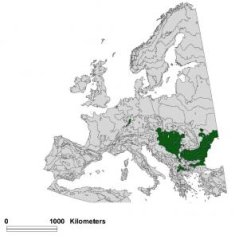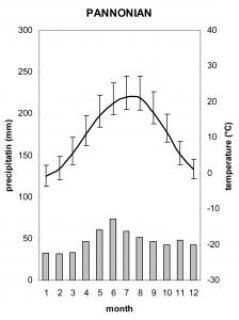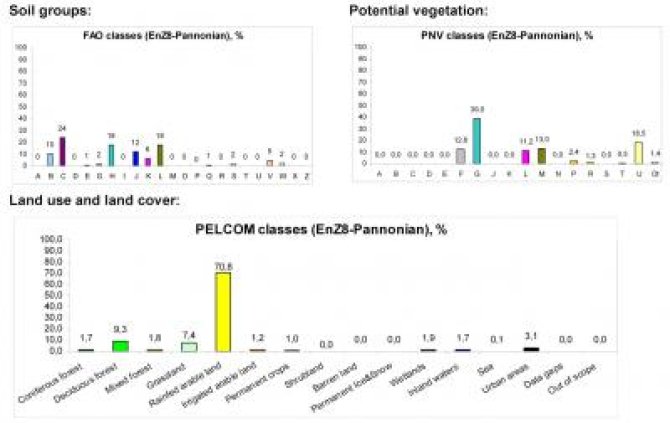
Pannonic-Pontic (PAN)
The Environmental zone Pannonian occupies lowlands, valleys and mountain peripheries on the Middle- and the Lower-Danube Plainsand the Black-Sea Lowland. In the classification also a small part of the Rhine Valley (Rheingraben) has been included due to its specific climatic conditions.

Thie zone is characteristic for the flat relief, dry continental climate (maximum of precipitations in summer, the yearly amplitude of temperature is 20°) and steppe-like natural vegetation. The formations dominated by trees grow only along the rivers (willow, black poplar) and in the mountain peripheries (oak). The growing season lasts 250 days (245-252), the sum of temperatures above +10° is 4099°C (3831°- 4361°).

The zone is geologically characterized as part of theNorth Black Sea plain, the mantle of Epi-Palaeozoic platform (Rein Graben and South of Lower-Danube Plain) and the Alpine Orogenic belt, The Middle Danube Plane is dominated by Pleistocene and Holocene, the Valley of Struma by Middle Pre-Cambrian-Lower Palaeozoic, and the Black Sea Lowland by Miocene and Pliocene deposits. The Middle Danube Plane is dominated by Pleistocene and Holocene that change in the south to Pliocene, the Lower Danube Plane is dominated by Pliocene, Pleistocene in the north and Cretaceous in the South, the Thrakian Lowland by Pleistocene that changes to Pliocene in the west and Cretaceous and Middle Palaeozoic in the east, the Black Sea Lowland is dominated by Pliocene formations.
The dominating Quaternary deposits are alluvial in the central part of the Middle-Danube Plain, eluvial-deluvial in its peripheral zones and in the Valley of Struma, and loess rocks on the elevated watersheds in the central zone of the Middle Danube Plain and on the Black Sea Lowland. The Thrakian Lowland is covered by eluvial-deluvial and alluvial, the Black Sea Lowland by loess deposits.
The potential natural vegetation is dominated by mixed Acer and Turkish oak forests as well as steppe vegetation (Stipa sp. grasslands). Therefore, historically the area the area is dominated by grassland farming; nowadays many areas are converted into crops. The Rheingraben has a long tradition of viticiulture.
